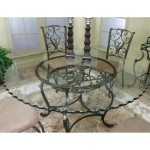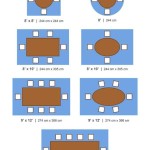Dining Room Table Area Rug Size
Choosing the right area rug size for a dining room table can significantly impact the room's overall aesthetic and functionality. A rug that is too small can make the space feel disjointed, while one that is too large can overwhelm the room. This article will explore the key factors to consider when selecting the appropriate dining room rug size.
The primary consideration is the size of the dining table itself. The rug should be large enough to accommodate the table and all the chairs, even when they are pulled out for seating. This ensures that the chair legs remain on the rug, providing stability and preventing damage to both the floor and the rug. A common mistake is choosing a rug that only fits the table when the chairs are tucked in. This creates a tripping hazard and can damage the rug edges over time.
A general rule of thumb is to add 24 to 36 inches to the length and width of the dining table to determine the minimum rug size. For example, a 6-foot long dining table would require a rug that is at least 8 feet long (6 feet + 2 feet). Similarly, a 4-foot wide table would need a rug that is at least 6 feet wide (4 feet + 2 feet). This additional space allows ample room for chairs to be pulled out comfortably without the back legs falling off the rug.
For rectangular tables, rectangular rugs are typically the most suitable choice. They mirror the table's shape, creating a cohesive and balanced look. Round or oval rugs can also be used with rectangular tables, but careful consideration should be given to the proportions to ensure a harmonious aesthetic. The diameter of a round rug should ideally be larger than the length of a rectangular table to provide sufficient coverage.
Round dining tables pair well with round or square rugs. The rug's diameter should be significantly larger than the table's diameter to accommodate the chairs. A good rule of thumb is to add at least 48 inches to the table's diameter to determine the minimum rug diameter. For example, a 48-inch diameter table would require a rug that is at least 8 feet in diameter (48 inches + 48 inches).
The shape and size of the dining room itself also play a crucial role in rug selection. In a smaller dining room, a larger rug can create the illusion of more space by anchoring the furniture and defining the dining area. However, it's important to leave a border of bare floor between the rug and the walls. A general guideline is to leave 18 to 24 inches of floor space around the rug's perimeter. This border helps to visually separate the dining area from the rest of the room and prevents the rug from appearing too overwhelming.
In larger dining rooms, a smaller rug can make the space feel cozy and intimate. However, the rug should still be large enough to accommodate the table and chairs comfortably. It's important to strike a balance between creating a defined dining area and maintaining a sense of spaciousness.
The rug's material and pile height should also be considered. Dining rooms are high-traffic areas, so a durable and easy-to-clean rug is essential. Low-pile rugs are generally preferred for dining rooms as they are easier to clean and prevent chairs from catching on the rug fibers. Materials such as wool, polypropylene, and synthetic blends are popular choices for dining room rugs due to their durability and stain resistance.
The rug's pattern and color can significantly impact the room's overall style. A bold, patterned rug can add visual interest and personality to a neutral dining room. Conversely, a solid-colored rug can create a more understated and elegant look. It's important to choose a rug that complements the existing decor and creates a cohesive design.
Budget is another important factor to consider. Rug prices can vary widely depending on the size, material, and construction. It's important to set a budget before beginning the rug selection process to narrow down the options and avoid overspending.
Measuring the dining room and the dining table is crucial before purchasing a rug. Accurate measurements will ensure that the chosen rug fits the space appropriately and provides adequate coverage for the table and chairs. Using painter's tape to mark out the desired rug size on the floor can be a helpful visualization technique.
Finally, consulting with a rug specialist can be beneficial, especially for those who are unsure about which size or style of rug to choose. A rug specialist can provide expert advice and guidance on selecting the perfect rug to complement the dining room and meet specific needs.

How To Choose The Right Rug Size

Expert Advice How To Design A Perfectly Scaled Dining Room Rug Size Layout Carpet

What Size Rug To Use For Your Dining Room

Rug Size Guide Ballard Designs

Sparkling Typical Rug Sizes Graphics Luxury Or Dining Room Rugs Size Area Table

What Size Rug Under Dining Table Here S The Best Way To Find Righ

Rug Size Guide Choose The Right

Everything You Need To Know About Dining Rooms Your Guide Getting The Scale Just Right Kayla Simone Home

Rug Size Guide Ballard Designs

How To Choose The Right Dining Room Rug Size








